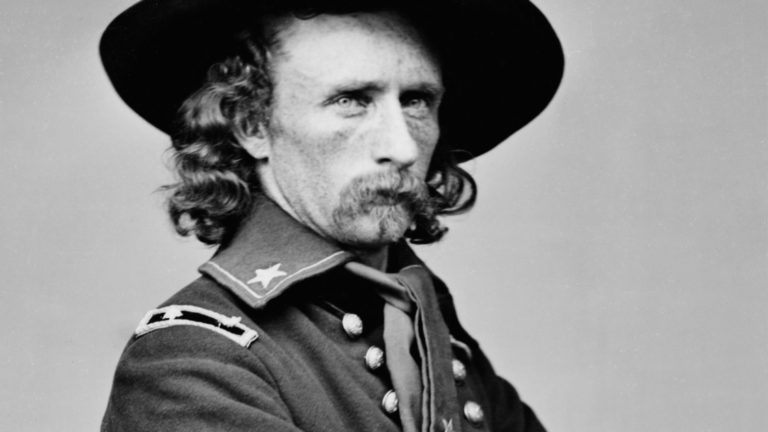Custer chose to remain in the army after the war. After the grand review he was ordered to Texas, to command a division of cavalry. He was made chief of cavalry in November of 1865, and remained on this duty until March 1866, when he was mustered out of the volunteer service. He applied to the government for permission to accept the position of chief of Mexican cavalry from Mexican President Juarez in the struggle against Maximilian. President Johnson declined to give the necessary leave of absence, and General Custer decided to accept the rank of lieutenant colonel of the 7th cavalry on July 28, 1866. He joined his regiment at Fort Riley, Kansas, in November of 1866, and served on the southern plains until 1871. Custer remained its active commander until his death. He took part in the 1867 Sioux and Cheyenne expedition, but was court-martialed and suspended from duty for one year for an unauthorized visit to his wife.
One of his friends wrote under his name in one sentence, “This was a man.” He stood nearly six feet in height, broad-shouldered, lithe, and active, with a weight never above 170 pounds. His eyes were blue, his hair and mustache of golden tint. He was reported to be a man of immense strength and endurance, and, as he used neither liquors nor tobacco, his physical condition was perfect through all the hardships of his life. Custer’s flamboyant personal style and forceful personality garnered the attention of his era. Was Custer a magnetic, fearless hero or a shameless glory seeker? Even today the debate continues.
In 1871, General Custer began to contribute articles on frontier life to the “Galaxy,” which were eventually published in book form under the title “My Life on the Plains” (New York, 1874). Ironically, Custer also had a keen interest in the life and culture of the Plains Indians. On November 27, 1871 he fought in the battle of the Washita, in Indian Territory, and inflicted such a humiliating and total defeat upon the Indians that the entire tribe of Cheyennes were forced to return to their reservation. Custer and his command were accused of numerous atrocities against the various Indian tribes of the region. He and his regiment were ordered to Kentucky in 1871, where he remained until 1873. In the spring of that year he and the 7th were sent to Fort Rice, Dakota, and from there accompanied an expedition to the Yellowstone country. Custer’s reputation only grew with the tribes of the Northern Plains during the hostilities of this era.
In July, 1874, the government ordered an expedition commanded by General Custer, into the Black Hills, which resulted in the unexplored region being opened to miners and settlement. At this time, he was engaged in the writing of a series of “War Memoirs” for the “Galaxy”. Due in part to his war heroism and name recognition, Custer was reportedly being considered in certain circles as a possible Presidential candidate in 1876 or 1880. Some warriors were later reported to have felt a certain respect for Custer’s courage and techniques in battle. He was a man that appeared to be either loved or hated – there was seemingly nothing in between.
On May 15, 1876, Custer took command of his 7th Cavalry regiment in a campaign against the allied Sioux and Cheyenne forces. The Indian’s main camp was discovered on the Little Bighorn River, in southeastern Montana. Custer’s army career as well as his life ended June 25, 1876, at the Battle of Little Bighorn, which resulted in the annihilation of his immediate command and a total loss of over 200 officers and men.
On June 28th, the bodies of the fallen troops were given a hasty burial on the battlefield. The following year, Custer’s remains were disinterred and given a military funeral at West Point. In 1879 the gravesite at the Little Bighorn battlefield was made a national cemetery, and later in 1939 a national monument

